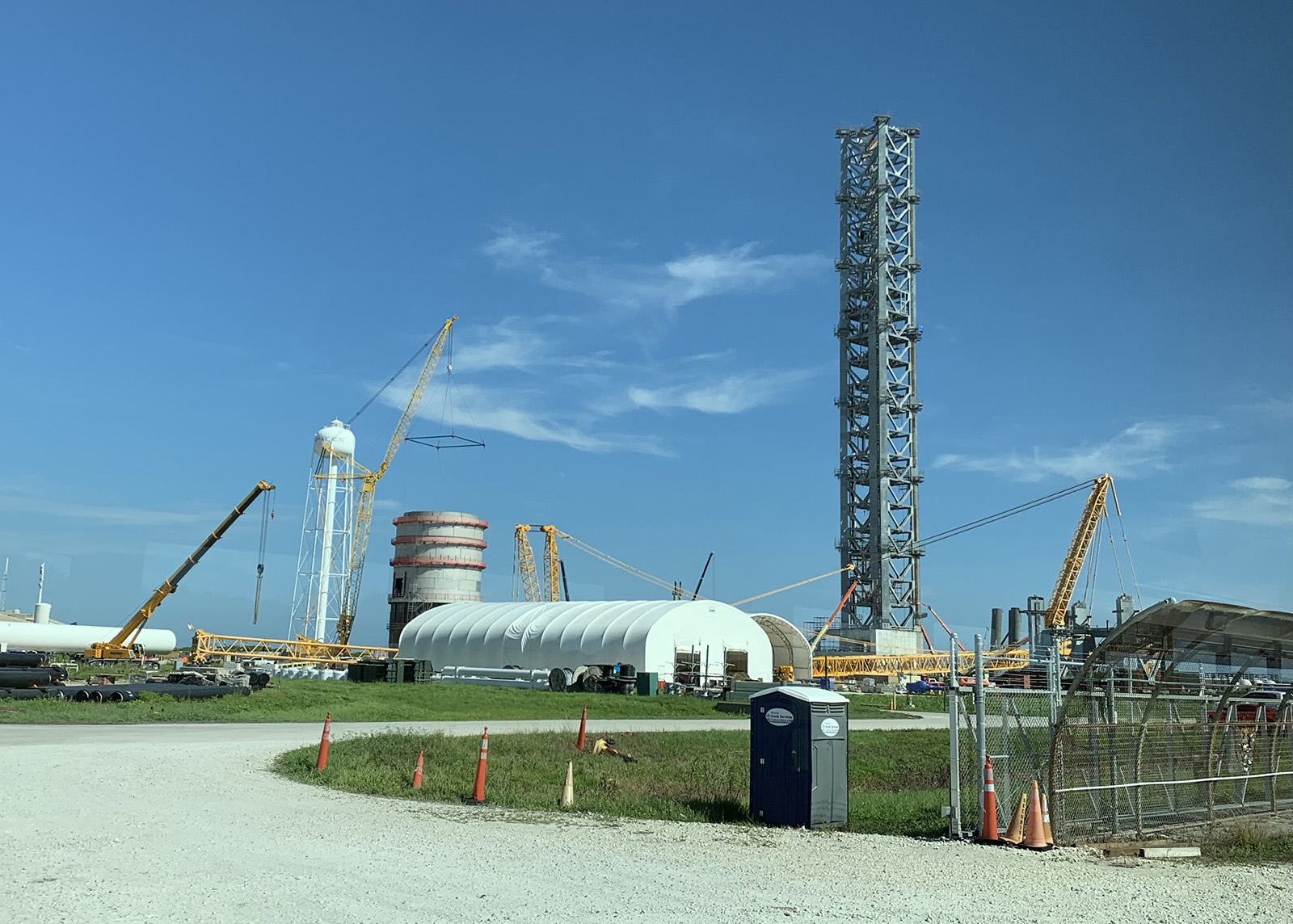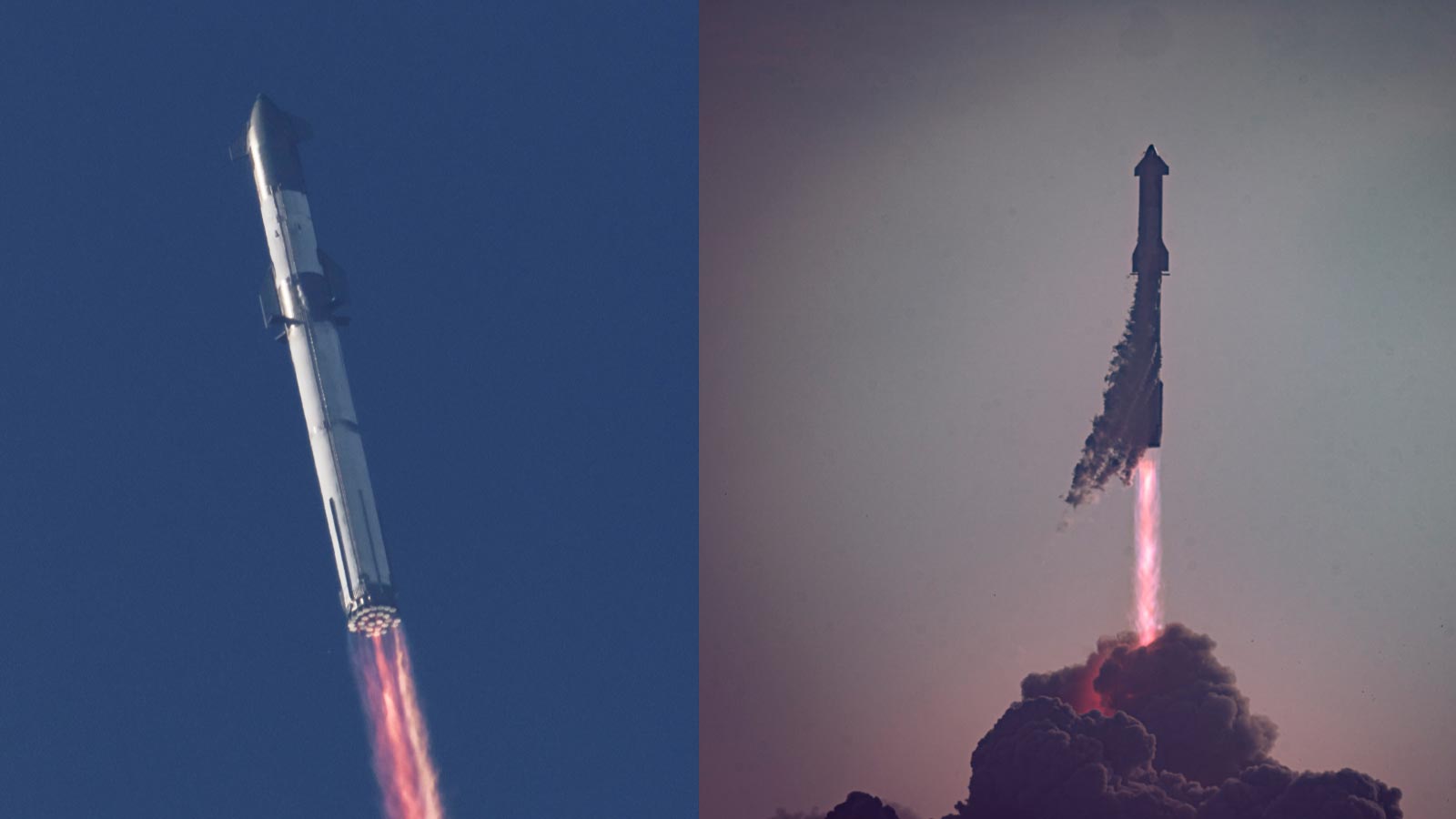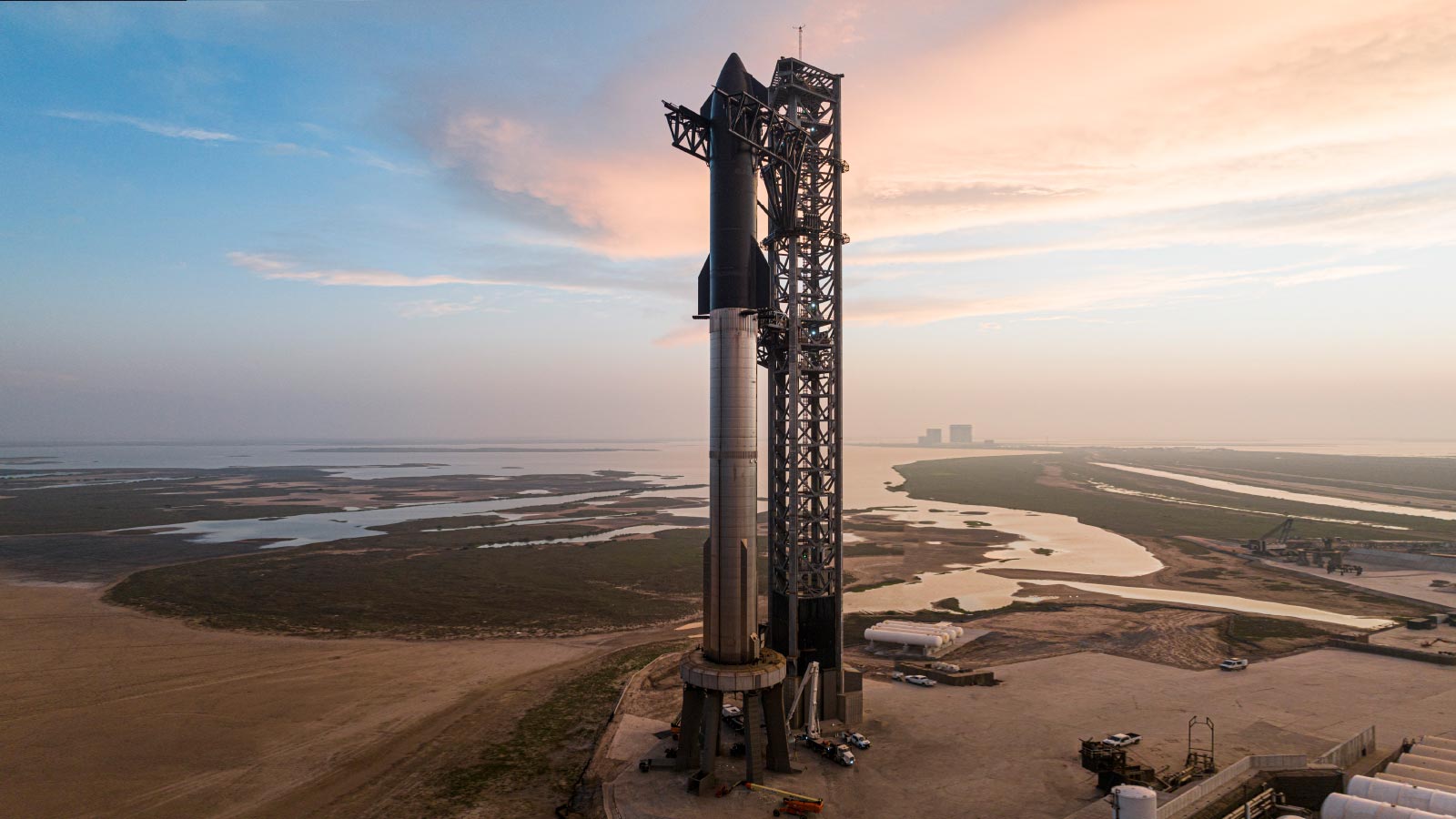Stay Up to Date
Submit your email address to receive the latest industry and Aerospace America news.
Looking at history, the safe bet is that SpaceX will ultimately resolve the troubles that marred its first attempt to get a Starship spacecraft into space. At the moment, SpaceX faces technical and legal challenges that could slow its hopes for a quick return to flight for its Starship-Super Heavy combination and also complicate efforts to start launching the vehicles from Florida. Jonathan O’Callaghan investigates.
The messy Starship launch in April was the latest example of SpaceX learning on the fly, failures be damned, in the same way it developed its Falcon fleet of rockets. Despite the excitement about launching a Starship atop a Super Heavy booster for the first time, the explosive liftoff and fiery ending over the Gulf of Mexico well short of space presents the company with a host of technical, regulatory and legal hurdles that are just now coming into full view.
SpaceX in all likelihood will need to clear each of these hurdles to resume test flights from its Starbase site in Boca Chica, Texas. That would be a step toward achieving Starship’s $2.9 billion role of shuttling astronauts between lunar orbit and the surface during the planned return of U.S. astronauts to the moon under the Artemis program. That historic mission is now likely to slip to 2026, according to NASA, in part because of the Starship setback.
Also at stake is the eventual launching of Starships from Kennedy Space Center in Florida. The center’s location on Cape Canaveral provides easy access to ascent over the Atlantic Ocean, away from populated areas, whereas Starbase is located on the Gulf of Mexico, a body of water ringed almost entirely by land. That said, NASA public affairs tells me the agency “does not have a requirement for Starship to launch from Florida.”
Requirement or not, over the last two and a half years, concrete and steel structures for launching Starships have slowly sprouted from the scrub of Cape Canaveral seashore across the way from NASA Kennedy’s business offices and media site. Unlike Boca Chica, where Starships are the only rockets around, the Cape hosts a variety of launch providers and is home to infrastructure that NASA, presumably, won’t permit SpaceX to put at risk, although the agency would not make anyone available for an interview about this topic.
The new pad is emerging on Launch Complex-39A, just meters from the Falcon pad where astronauts Bob Behnken and Doug Hurley climbed into a SpaceX Crew Dragon capsule in 2020 and flew to the International Space Station. That mission marked the restoration of the U.S. ability to deliver astronauts to ISS on American-made spacecraft. Thirty-six spacefarers have since been launched from that pad, including three all-private crews. Students of history will also recall that this pad is the one where Apollo 11’s Saturn V lifted off in 1969 and where the first space shuttle lifted off in 1981.

The notion of launching the world’s most powerful rocket so close to such important infrastructure might seem foolhardy, were it not for a notable addition planned for the Cape, and ultimately for Boca Chica: a method to redirect the thrust of liftoff away from the pad. Traditionally, this would be accomplished via a flame trench, but SpaceX has instead opted for a “water-cooled steel plate” — a flame diverter. The trouble was, one was not installed for the inaugural launch in April. Two and a half years earlier, Elon Musk issued a now famous tweet: “Aspiring to have no flame diverter in Boca, but this could turn out to be a mistake.” Forgoing the diverter was indeed a mistake, judging by the fact that the ignition of Super Heavy’s Raptor engines blew a crater into the concrete launch pad and spewed a plume of pulverized concrete for kilometers. At the Cape, long before the April launch, NASA made clear that it had no intention of taking such a risk even for one launch: A 2019 environmental assessment conducted by NASA and SpaceX for the Cape site said a “water cooled flame diverter” consisting of metal piping would be constructed and “positioned directly under the rocket,” in lieu of a flame trench like the one at the Falcon pad. (NASA would not say whether this is still the plan.) The day after the April launch, Musk tweeted that construction of a diverter for Boca Chica had begun three months earlier but wasn’t ready. “We wrongly thought, based on static fire data, that Fondag” — an industrial concrete — “would make it through 1 launch.”
In follow-up comments on Twitter, Musk suggested Starship could return to flight some three months after the test flight. That prediction now seems optimistic. FAA as of late June had yet to receive the “final mishap investigation” report it requested of SpaceX following the test flight, emphasizing in response to my questions that it will be “involved in every step of the process.” That report must identify “final corrective actions” that SpaceX will have to implement before FAA permits another Starship launch.
“The FAA isn’t going to speculate when the SpaceX Starship / Super Heavy vehicle returns to flight,” the agency said. “Public safety and actions yet to be taken by SpaceX will dictate the timeline.”
At Boca Chica in April, SpaceX took “too much of a risk,” says Philip Metzger, a planetary scientist at the University of Central Florida who has been studying the aftermath of the pad’s destruction. As bad as it was, things could have been worse. “The concrete chunks could have struck the vehicle and resulted in catastrophic loss of the vehicle while it was still low. That could have destroyed the entire launch structure.”
Plans call for the same infrastructure at the two sites: an elevated concrete ring on six stout concrete legs, a flame diverter under it, and a launch tower with the two “chopsticks” that will hold a fully stacked Starship and Super Heavy booster and catch the booster on its return to the launch pad.
An open question is whether SpaceX’s water-cooled steel plate apparatus, rather than a flame trench, will be enough to satisfy NASA now that the power of Super Heavy has been demonstrated so vividly at Boca Chica. In a response to my questions, the agency said it was “working with SpaceX to ensure the updated pad remains compliant with the requirements of the property agreement for the use of LC-39A.” Those requirements include “construction, safety and environmental concerns,” with SpaceX’s designs “reviewed by NASA for their impact to the center.” SpaceX did not respond to a request for comment.
NASA and SpaceX have long been working together closely. In 2021, at SpaceX’s request, NASA began an environmental assessment about launching Starships from a yet-to-be-constructed pad, Launch Complex-49, that would be located north of LC-39A and LC-39B, the Space Launch System site. LC-49 is referenced in the Kennedy Space Center Master Plan. If dedicated to Starship, it “would provide redundancy and capacity and allow SpaceX to increase the flight rate of Starship,” according to NASA. That might be necessary for the multiple refuel flights needed to get a single Starship to lunar orbit, where it would pick up astronauts from an Orion capsule and bring them to the surface and back. Two towers might be built at LC-49 for launching Starships, giving the Cape three separate Starship launch sites.
Bad ending
The corrective actions required for return to flight seem certain to involve the flight termination system, or FTS, which failed to immediately destroy Starship when it began to tumble about four minutes into the launch. Musk tweeted that the final destruction came as the rocket fell back into the thicker atmosphere, about 40 seconds after the command for detonation was sent.
“That was bad,” says Charlie Garcia, chief engineer at Colorado-based Agile Space Industries, who follows SpaceX’s operations. “As far as the most concerning things about the flight, that one would be at the top of my list.”
A wayward rocket that doesn’t respond to a self-destruct command could fly off course and potentially rain debris over inhabited land, rather than the ocean as intended. “The risk is always that the rocket goes somewhere you don’t want it to,” says Garcia. “That’s why the FTS exists.”

Jim Knauf, a retired U.S. Air Force colonel and former chair of AIAA’s Space Transportation Technical Committee, says the FTS problem was “unacceptable” but solvable. “I think the fix will be relatively straightforward,” he says. “Then they’ve got to get FAA approval and convince them they’ve fixed it.”
Then there was the apparent failure of up to seven of Super Heavy’s 33 methane-fueled Raptor engines. Given the “unprecedented” number of engines, says Knauf, failures would have been expected. But ironing out those issues will be crucial before Starship can safely launch from the Cape.
Former NASA official Daniel Dumbacher, executive director of AIAA, says that data displayed by SpaceX in its livestream showed that “some of [the engines] did not start, and some of them did not operate going uphill.” SpaceX needs to “understand what, if any, impact that had on the control systems that led to the aerodynamic breakup,” he says.
The engine failures could take some time to solve. “I doubt there’s a simple solution,” says Garcia. “Raptor is a very complicated and relatively new engine. I think there’s definitely a lot of learning to do. I don’t see any major stumbling blocks; it’s just a lot of work by the engineers.”
There is another potential barrier to the return to flight: a lawsuit filed against FAA in May in the U.S. District Court for the District of Columbia by five environmental groups. The lawsuit alleges that the potential for damage to the pad and surrounding wildlife at Boca Chica was not properly investigated by FAA before the launch as part of its environmental assessment. The suit asks the court to instruct FAA to “vacate” its original finding of “no significant impact” and order creation of a full EIS, the term for an environmental impact statement required by U.S. law in many instances. This full EIS should replace the “considerably less thorough” programmatic environmental assessment that FAA concluded in 2022, the suit says.
“Our position is a relatively straightforward one,” says Jared Margolis from the Center for Biological Diversity, the lead counsel on the case, who notes it could take months or even years to resolve the dispute. “It’s that the launch on April 20 proved that the impacts of the Starship Super Heavy program are more than significant.”
SpaceX currently has a license for 20 Starship launches from Boca Chica over the next five years and would need to reapply or request to modify its license if it wants to conduct more. Margolis wants that possibility to be carefully considered. “Maybe this isn’t the right place to be blowing up giant rockets,” he says. “This is one of the most important and biologically diverse areas in the country for wildlife. This is not some sacrifice zone, which is what they’re using it as. Moving it to Florida would resolve our concerns.”
Another crucial aspect yet to be tested is the refueling of Starship in space. Perhaps a dozen or more fuel-laden Starships would need to be launched, and these would transfer fuel to a depot in low-Earth orbit. Propellant would then be transferred to the moon-bound Starship to ready it to reach lunar orbit, where it would take the astronauts to the lunar surface and back.
How exactly that will be carried out needs to be tested, says Dumbacher. “The technology for that refueling process has not been demonstrated at scale,” he says. “All of that orchestration of those launches has to work correctly. There are some hurdles ahead that have to be addressed.”
Despite the issues at hand, however, there remains optimism that Starship can succeed. “NASA knows that the development of a new launch vehicle takes time and likely will have setbacks,” says Laura Forczyk of the Astralytical consultancy. “I do not think Starship’s messy progress is a surprise to NASA at all. NASA has a long working relationship with SpaceX and understands how the company prefers to test its prototypes.”
Adds Garcia, “I expect SpaceX to once again surprise people with how rapidly it is able to transition from a very experimental vehicle to operating an incredibly efficient launch system.” That could ultimately see a refined Starship launching from multiple sites, including the Cape and Boca Chica. “If SpaceX really is trying to fly this thing 1,000 times a year, they may need more launch pads,” says Garcia. “That would be three flights a day.”
Dumbacher is similarly bullish. “I have no doubt that it’s going to be successful. It’s just going to be a matter of how much time and effort it’s going to take.”
Given Starship’s potentially transformative capabilities, both with the amount of mass each rocket could take to space — up to 250,000 kilograms — and the design’s touted low-cost of operations, many are eager to see fully operational launches soon.
Whether those launches will predominately take place from the Cape or Starbase remains to be seen.
“Two years ago, the idea was that Boca Chica would be this major launch facility,” says Eric Roesch, a U.S.-based environmental compliance and policy expert. “I think that is very much to be determined.”
About Jonathan O'Callaghan
Jonathan is a London-based space and science journalist covering commercial spaceflight, space exploration and astrophysics. A regular contributor to Scientific American and New Scientist, his work has also appeared in Forbes, The New York Times and Wired.
Related Posts
Stay Up to Date
Submit your email address to receive the latest industry and Aerospace America news.




